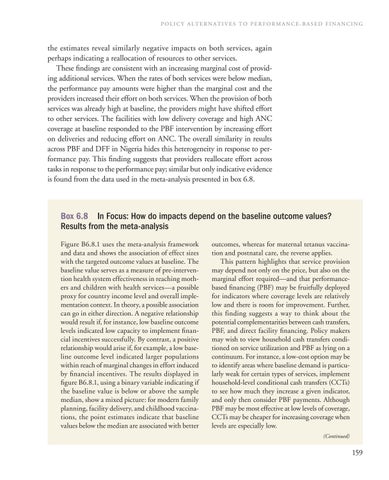POLICY ALTERNATIVES TO PERFORMANCE-BASED FINANCING
the estimates reveal similarly negative impacts on both services, again perhaps indicating a reallocation of resources to other services. These findings are consistent with an increasing marginal cost of providing additional services. When the rates of both services were below median, the performance pay amounts were higher than the marginal cost and the providers increased their effort on both services. When the provision of both services was already high at baseline, the providers might have shifted effort to other services. The facilities with low delivery coverage and high ANC coverage at baseline responded to the PBF intervention by increasing effort on deliveries and reducing effort on ANC. The overall similarity in results across PBF and DFF in Nigeria hides this heterogeneity in response to performance pay. This finding suggests that providers reallocate effort across tasks in response to the performance pay; similar but only indicative evidence is found from the data used in the meta-analysis presented in box 6.8.
Box 6.8 In Focus: How do impacts depend on the baseline outcome values? Results from the meta-analysis Figure B6.8.1 uses the meta-analysis framework and data and shows the association of effect sizes with the targeted outcome values at baseline. The baseline value serves as a measure of pre-intervention health system effectiveness in reaching mothers and children with health services—a possible proxy for country income level and overall implementation context. In theory, a possible association can go in either direction. A negative relationship would result if, for instance, low baseline outcome levels indicated low capacity to implement financial incentives successfully. By contrast, a positive relationship would arise if, for example, a low baseline outcome level indicated larger populations within reach of marginal changes in effort induced by financial incentives. The results displayed in figure B6.8.1, using a binary variable indicating if the baseline value is below or above the sample median, show a mixed picture: for modern family planning, facility delivery, and childhood vaccinations, the point estimates indicate that baseline values below the median are associated with better
outcomes, whereas for maternal tetanus vaccination and postnatal care, the reverse applies. This pattern highlights that service provision may depend not only on the price, but also on the marginal effort required—and that performancebased financing (PBF) may be fruitfully deployed for indicators where coverage levels are relatively low and there is room for improvement. Further, this finding suggests a way to think about the potential complementarities between cash transfers, PBF, and direct facility financing. Policy makers may wish to view household cash transfers conditioned on service utilization and PBF as lying on a continuum. For instance, a low-cost option may be to identify areas where baseline demand is particularly weak for certain types of services, implement household-level conditional cash transfers (CCTs) to see how much they increase a given indicator, and only then consider PBF payments. Although PBF may be most effective at low levels of coverage, CCTs may be cheaper for increasing coverage when levels are especially low. (Continued)
159

